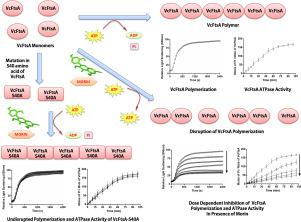Biochimica et Biophysica Acta (BBA) - General Subjects ( IF 2.8 ) Pub Date : 2021-05-20 , DOI: 10.1016/j.bbagen.2021.129931 Debasish Nag 1 , Debabrata Ghosh Dastidar 2 , Gopal Chakrabarti 1

|
Background
Increasing antibiotic-resistance in bacterial strains has boosted the need to find new targets for drug delivery. FtsA, a major bacterial divisome protein can be a potent novel drug-target.
Methods and results
This study finds, morin (3,5,7,2′,4′-pentahydroxyflavone), a bio-available flavonoid, had anti-bacterial activities against Vibrio cholerae, IC50 (50 μM) and MIC (150 μM). Morin (2 mM) kills ~20% of human lung fibroblast (WI38) and human intestinal epithelial (HIEC-6) cells in 24 h in-vitro. Fluorescence studies showed morin binds to VcFtsA (FtsA of V. cholerae) with a Kd of 4.68 ± 0.4 μM, inhibiting the protein's polymerization by 72 ± 7% at 25 μM concentration. Morin also affected VcFtsA's ATPase activity, recording ~80% reduction at 20 μM concentration. The in-silico binding study indicated binding sites of morin and ATP on VcFtsA had overlapping amino acids. Mant-ATP, a fluorescent ATP-derivative, showed increased fluorescence on binding to VcFtsA in absence of morin, but in its presence, Mant-ATP fluorescence decreased. VcFtsA-S40A mutant protein did not bind to morin.
Conclusions
VcFtsA–morin interaction inhibits the polymerization of the protein by affecting its ATPase activity. The destabilized VcFtsA assembly in-turn affected the cell division in V. cholerae, yielding an elongated morphology.
General significance
Collectively, these findings explore the anti-bacterial effect of morin on V. cholerae cells targeting VcFtsA, encouraging it to become a potent anti-bacterial agent. Low cytotoxicity of morin against human cells (host) is therapeutically advantageous. This study will also help in synthesizing novel derivatives that can target VcFtsA more efficiently.
中文翻译:

在 ATP 结合位点附近与细胞分裂蛋白 FtsA 结合后,天然黄酮类桑椹素显示出对霍乱弧菌的抗菌活性
背景
细菌菌株中抗生素抗性的增加促进了寻找新的给药靶点的需求。FtsA 是一种主要的细菌分裂蛋白,可以成为一种有效的新型药物靶点。
方法和结果
本研究发现,morin (3,5,7,2',4'-pentahydroxyflavone) 是一种生物可利用的黄酮类化合物,对霍乱弧菌、IC 50 (50 μM) 和 MIC (150 μM)具有抗菌活性。Morin (2 mM)在体外24 小时内杀死约 20% 的人肺成纤维细胞 (WI38) 和人肠上皮 (HIEC-6) 细胞。荧光研究表明,morin 与 VcFtsA(霍乱弧菌的FtsA )结合的 K d4.68 ± 0.4 μM,在 25 μM 浓度下抑制蛋白质聚合 72 ± 7%。Morin 还影响了 VcFtsA 的 ATPase 活性,在 20 μM 浓度下记录了约 80% 的减少。计算机内结合研究表明,VcFtsA 上的morin 和ATP 的结合位点具有重叠的氨基酸。Mant-ATP 是一种荧光 ATP 衍生物,在没有 Morin 的情况下与 VcFtsA 结合时显示出增加的荧光,但在它存在时,Mant-ATP 荧光降低。VcFtsA-S40A 突变蛋白不与morin 结合。
结论
VcFtsA-morin 相互作用通过影响其 ATP 酶活性来抑制蛋白质的聚合。不稳定的 VcFtsA 组装反过来影响霍乱弧菌的细胞分裂,产生拉长的形态。
一般意义
总的来说,这些发现探索了桑椹素对靶向 VcFtsA 的霍乱弧菌细胞的抗菌作用,促使其成为一种有效的抗菌剂。Morin 对人类细胞(宿主)的低细胞毒性在治疗上是有利的。这项研究还将有助于合成可以更有效地靶向 VcFtsA 的新型衍生物。











































 京公网安备 11010802027423号
京公网安备 11010802027423号